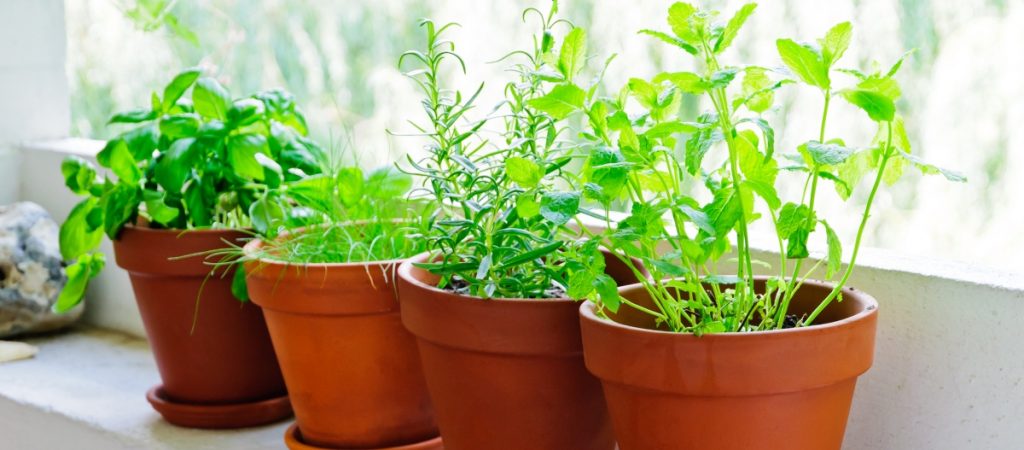Everybody can benefit from a container herb garden. That’s true regardless of whether you live in an apartment or you’ve got several acres of land.
There are some special requirements of container gardening that you need to know about to maximize your success though.
Luckily, having a herb garden container is fairly low-effort and easy once you know what’s needed.
In this article, you’ll learn the supplies needed and a step-by-step process for creating your own container herb garden.
But first, let’s explain exactly what we mean by a container herb garden.
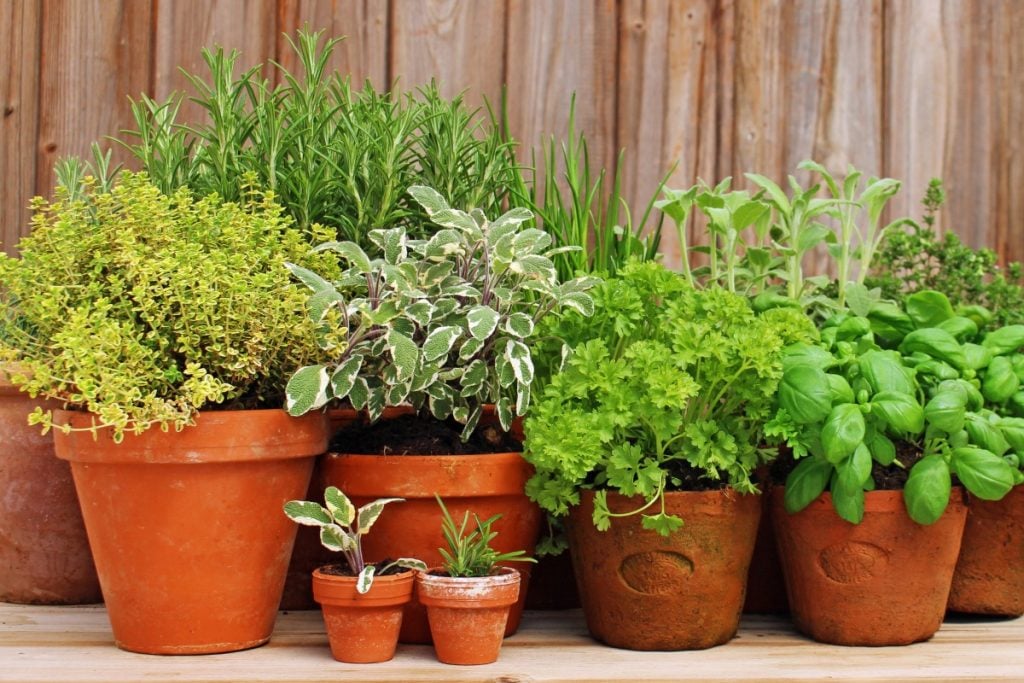
What is a Container Herb Garden?
A container herb garden is exactly what it sounds like. It’s growing herbs and other smaller plants in self-contained containers like pots, hanging baskets, or grow bags.
Raised beds are a larger form of container garden. You can also create your own container herb garden from recycled materials like milk crates.
See our article How to Plant a Milk Crate Garden for a full explanation if that sounds like something that you’d be interested in.
A container herb garden is a convenient way to grow some fresh cooking ingredients. No matter how much or how little space you’ve got.
If you live in an apartment, you can set up a container herb garden on your balcony. Or even indoors on a sunny windowsill.
Even if you’ve got a large farm, we think that setting up a container herb garden still makes sense.
That way, you won’t have to walk way out to the garden every time that you want to harvest some fresh herbs.
Your annual and perennial herbs will be just a few steps from your backdoor. That makes it super convenient to step out and pick a handful of fresh herbs whenever you need them.
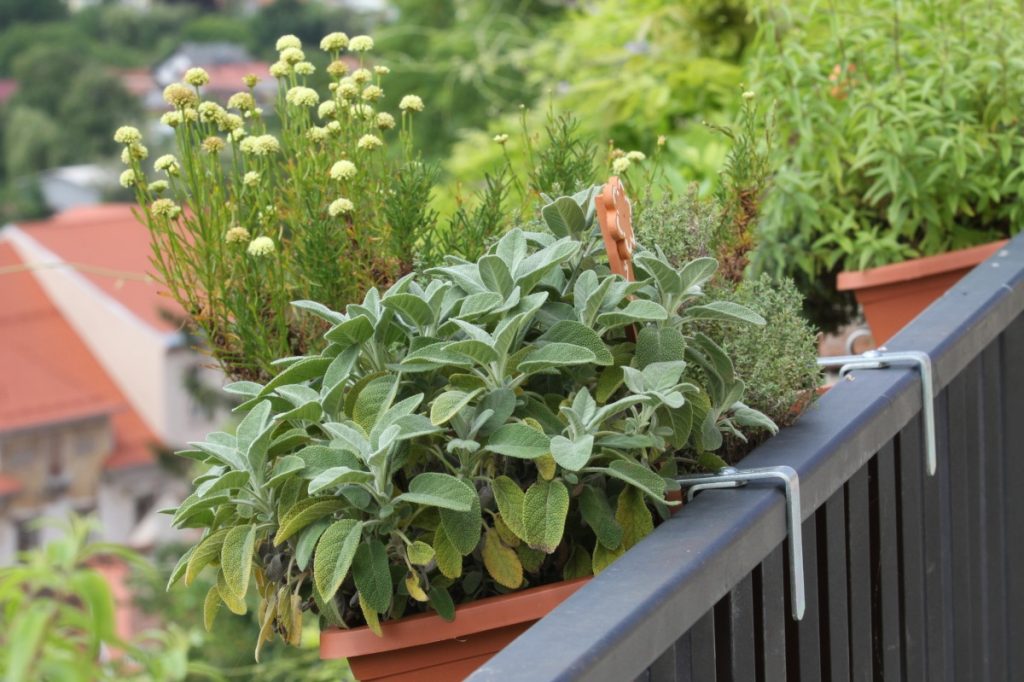
How Do Container Herb Gardens Tie Into Homesteading?
As we mentioned above, creating a container herb garden makes sense even in the context of a larger homestead.
It makes it easier to quickly grab some herbs without having to walk to your main garden. Which may be hundreds of feet away from your house.
Container gardens are also a great way to create a salad garden for the same reason.
Keeping a few of your most-used plants close to your home saves you a lot of time and effort. Especially if you’re making a salad with your dinner every night.
Thinking about adding some salad mix to your container garden? Be sure to read our article How to Create a Salad Garden to learn what to plant, and how to design it.
A container herb garden also helps your homestead by adding additional layers to your forest garden or forest farm.
Planting in containers may feel very separate from the rest of your homestead.
But plants in container gardens can still help to add biodiversity to your land and attract more beneficial insects.
Are Potted Herbs Worth It?
Setting up your container herb garden layout will take some upfront investment. So while you’re buying all of your supplies, you might start to wonder if potted herbs are really worth it.
While growing herbs isn’t very labor intensive, they’ll still require a little maintenance. You’ll need to water them every few days, at the very least.
In our opinion, it’s still very much growing your own herbs, though.
One bunch of an herb like dill, cilantro or parsley at the grocery store can cost several dollars. When measured by weight, herbs are one of the most expensive items in the produce section.
So if you cook with herbs regularly, you can quickly make your money back from the initial setup costs by growing them yourself.
In addition to saving money, you just can’t beat the freshness of growing herbs yourself.
Many herbs begin to wilt, dry out and lose their essential oils just hours after being picked.
So the flavor of fresh-picked herbs will always beat those that have spent several days going through the process of being shipped and put on display.
Lavender is an herb that you can base an entire business around. See our article The Complete Guide to Growing Lavender for Profit to learn more.
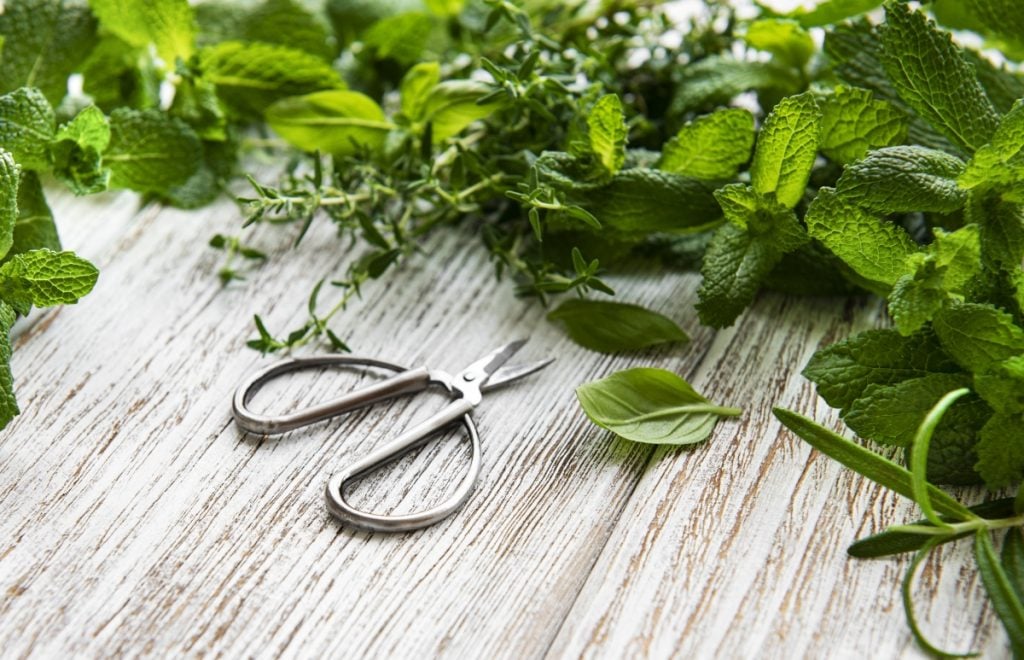
Supplies Needed to Create a Container Herb Garden
You won’t need too much to create your container herb garden.
The supplies should only cost you about $25 (£17) to set up a few pots to get started.
Here’s what you will need:
1. A sunny spot to place your containers, or grow lights. Sunlight is free and what plants prefer.
If you’re in an apartment without any sunny windows, you might need to invest in a more expensive grow light setup to get started.
2. Soil to grow in. Since your plants are in small containers, it’s important to give them high-quality soil.
You can buy potting soil from garden centers that’s specifically formulated for growing in pots.
3. Fertilizer. Over time, your plants will eventually use up the nutrients in the soil. You’ll need to add fertilizer to keep them in top growing condition.
We recommend looking for an organic plant food. These contain natural ingredients like kelp, earthworm castings, and bone meal. As opposed to artificial chemicals.
A liquid fertilizer is best for container gardening. You just add it to water and then water your plants with it periodically.
Be sure to follow instructions on the product. Too much fertilizer can burn and damage your plants. It’s easy to add too much fertilizer to small containers. So try to err on the side of caution.
4. A watering can. Unless you’ve got a garden hose right by your back door, you’ll likely want a watering can for watering your container garden.
Small containers don’t require a large volume of water. So it’s often easier to fill a small watering can instead of unwinding a garden hose.
A watering can also allows for you to water more gently than using a more high-pressure hose attachment.
5. Herb seeds or seedlings. If you aren’t sure what herbs to buy, consider which herbs you tend to use most regularly in your cooking. There’s no point growing a bunch of herbs that you won’t eat.
Annual herbs like basil and dill need to be replanted every year.
Perennial herbs like sage, thyme and rosemary can be planted once and will keep growing again each year on their own.

How to Plant a Container Herb Garden Step by Step
If you’ve never done any gardening before, you might be asking yourself:
“How do I make an herb container garden?”
Fear not, a small herb garden is a great first-time gardening project to start with.
Here’s the steps you’ll want to take.
Step 1: Plan Your Herb Container
You can choose to grow just one kind of herb per container. Or you might want to combine multiple kinds of herbs into one container.
It’s important to put plants together that have similar requirements though. You’ll want to take soil, water, and sun preferences in mind.
For example, mint likes to grow in wet conditions. Meanwhile, rosemary likes dry and hot conditions. So you won’t want to put these types of herbs together in the same containers.
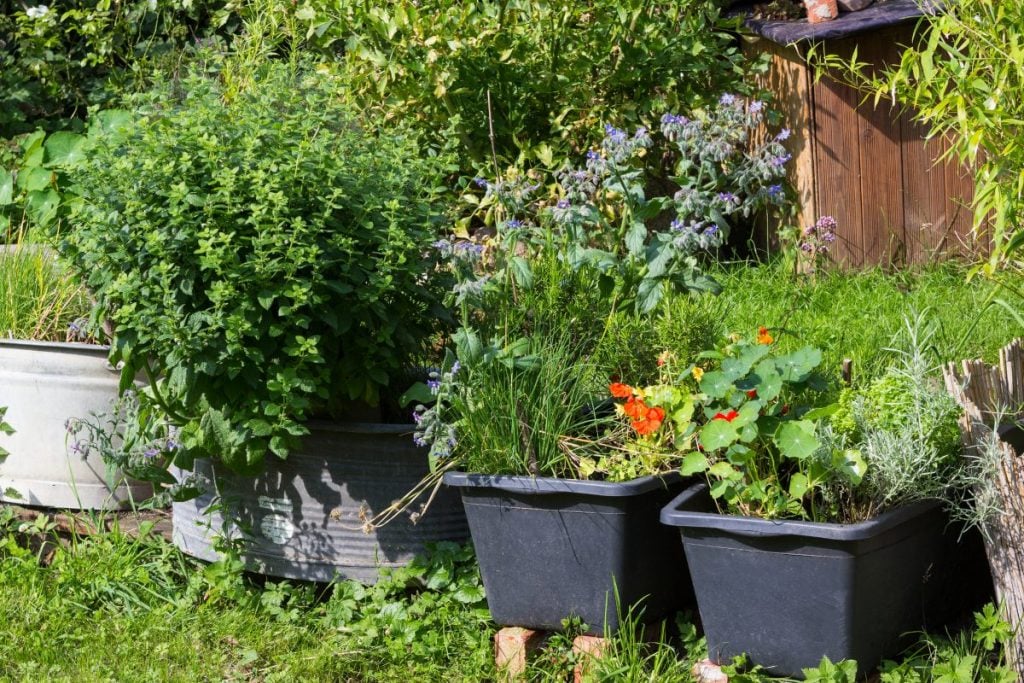
Step 2: Pick Your Container
You can buy specially-made herb containers at garden centers. Or you can re-use almost any kind of container for your herb garden ideas.
Just make sure it’s large enough, and add some holes for drainage to the bottom.
Most kinds of herbs don’t have very deep root systems. So they’ll do well in small and shallow containers.
However, their roots can still quickly expand and take up most of the container. So pick a container that does give them some room to grow.
Some stores even sell self-watering containers that provide a consistent amount of water. That way you don’t need to worry about plants drying out.
However, some herbs like basil and oregano like to dry out between waterings. So they won’t do as well in self-watering plants that are kept constantly moist.
Step 3: Plant Your Herbs
You should have all of the supplies that we discussed earlier. So now all you need to do is add soil to your pots as well as herb seeds or seedlings.
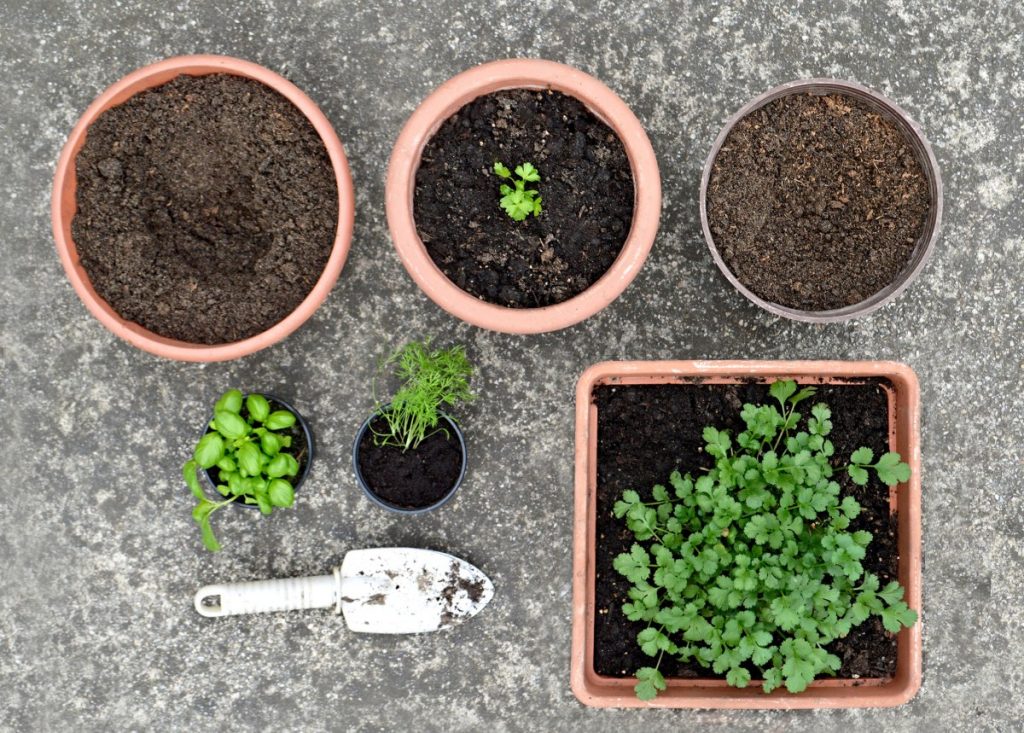
Step 4: Caring For Your Herbs
Care for your herbs by following the instructions that come with your herb plants or seeds that you buy. But generally, most herbs need six to eight hours of sunlight per day.
You can tell if your herbs need to be watered by sticking a finger below the surface of the soil. If it feels dry, then it’s likely time to water.
If you lift your herb containers, they’ll also be significantly lighter when they’re dry compared to wet.
In the heat of summer, small herb containers can get very hot. So you might want to place them somewhere that will get shade during the hottest part of the afternoon.
Also resist the temptation to fertilize your herbs too often. Follow instructions on your fertilizer and be sure to adjust based on your container sizes.
Too much fertilizer is bad for plants and can hurt them. Just like too much of one vitamin can be a bad thing for humans.
Step 5: Harvest Your Herbs
For most herbs, regularly cutting off growth will cause them to bush out and grow even larger and fill out even thicker.
So don’t be afraid to start harvesting some herbs even while your plants are small.
Just be sure to never remove more than a third of the plant at once. They still need lots of leaves to perform photosynthesis and stay healthy.
To harvest your herbs, we recommend using a sharp pair of scissors or a knife.
If you pull leaves off of your herbs with your fingers, you risk damaging the roots and other parts of the plant.
Some herbs may start developing flower buds later in the season. Generally it’s a good idea to remove these so the plant keeps putting its energy into producing more leaves.
Some flowers of herbs like dill are edible.
Other herbs like basil will start to become bitter and unenjoyable to eat once they start flowering. So if you aren’t sure, it’s best to just remove all flowers from your herbs.

Step 6: Keeping Your Herbs Over Winter
This is an optional step if you want to keep growing your herbs even when it’s cold outside.
If you don’t bring your herbs inside, some perennials will simply go dormant for the winter and come back in the spring.
Annual herbs will need to be replanted again in the spring.
Either kind of herb can be brought inside once the weather gets cold to extend your growing season though. You’ll just need a sunny window for them to continue to grow.
Some herbs are okay inside and others are more challenging to grow indoors. But if you want to continue enjoying your favorite herbs year-round, it might be worth trying.
Are you looking to create a more sustainable garden? Check out How To Start A Permaculture Garden: Step By Step Beginner’s Guide to see if a permaculture garden is right for you.
Step 7: Preserving Additional Herbs
You might be surprised with how many herbs you can get from a few small containers.
If you end up overwhelmed with the amount of fresh herbs you’re producing, you can dry them out to preserve them.
Use a food dehydrator or an oven on the lowest setting to remove all the moisture from your herbs. Then they can be stored in an airtight jar for months.

Pros and Cons of Container Herb Gardens
Pros
1. Great for beginners. Creating a container herb garden is great for building up your confidence as a new gardener.
It’s a lot less overwhelming to add a pot or two on your deck instead of a full garden.
2. Easier to maintain. Chances are that you won’t need to worry about weeding small containers. Generally all you need to do is water and add fertilizer.
3. More accessible. Container herb gardens are great for people with disabilities or reduced accessibility.
You can place them at heights that are comfortable for you to work with. So there’s no need to bend over or kneel like with a traditional garden.
Search online for some herb garden container ideas that suit your situation.
4. Small footprint. A container herb garden doesn’t take up much space. That makes it great even for people who live in an apartment and only have a balcony to grow on.
5. More convenient. You can place containers right outside of your door. That way it doesn’t take much effort to water or harvest fresh herbs.
You’re less likely to neglect your herbs if they’re within arms reach and always visible.
6. Portability. Containers are easy to pick up and move whenever you want.
Maybe as autumn approaches, your plants are getting more shade than in the summer. You can simply move them to a sunnier area in the yard.
If you end up moving, it’s easy to take your plants with you. No need to dig anything up.
If there’s hail or frost in the forecast, you can also bring your containers indoors to prevent damage.
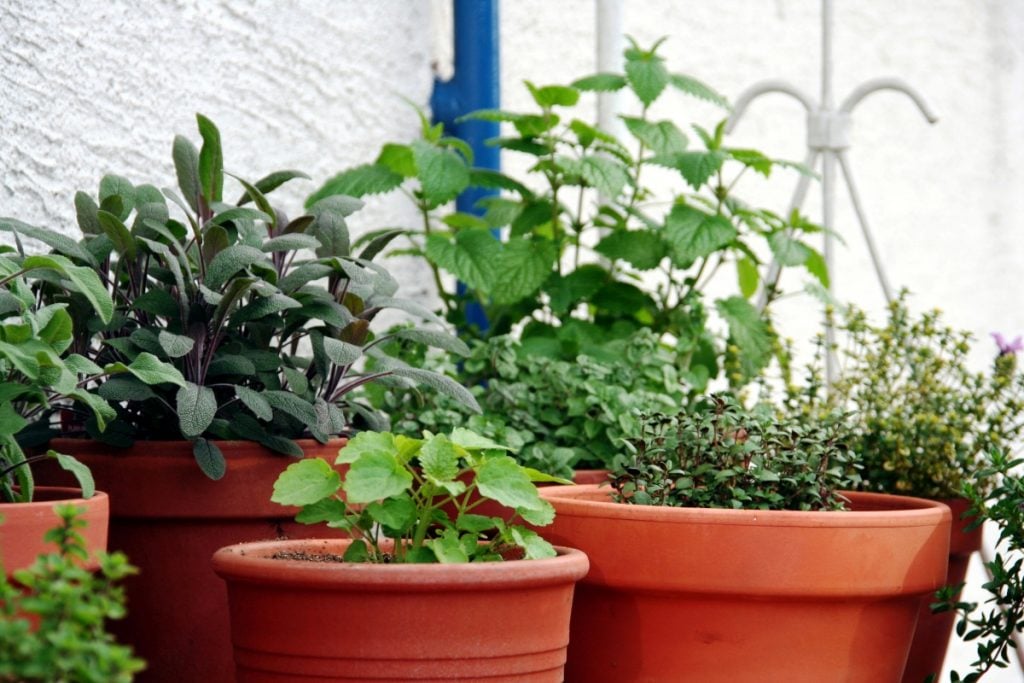
Cons
1. Containers dry out faster. Since containers are smaller, there’s less volume of soil in them to hold water.
They also tend to heat up quicker, leading to faster evaporation. So you’ll need to water more frequently compared to herbs that are in the ground.
2. They need fertilizer. In a garden, you can add compost and other materials to give nutrients to your plants. In small herb containers, you rely on fertilizer though.
It’s another input that you need to buy. And the need for fertilizer also makes container growing a bit less sustainable.
3. Plants can get rootbound. As plants grow above the soil, their roots are growing underneath too. Faster-growing herbs can quickly outgrow their containers.
That means you could need to replant them into a larger container later on. At least if you didn’t select a large enough container from the start.
4. Containers can blow over. A really strong gust of wind can push around or blow over plastic containers. Even if they’re full of soil.
This can damage your plants or send them flying out of the container entirely.
Containers can be expensive. There are lots of cheap and free options for containers. But if you have something particular in mind, you might end up paying a lot for them to look nice.
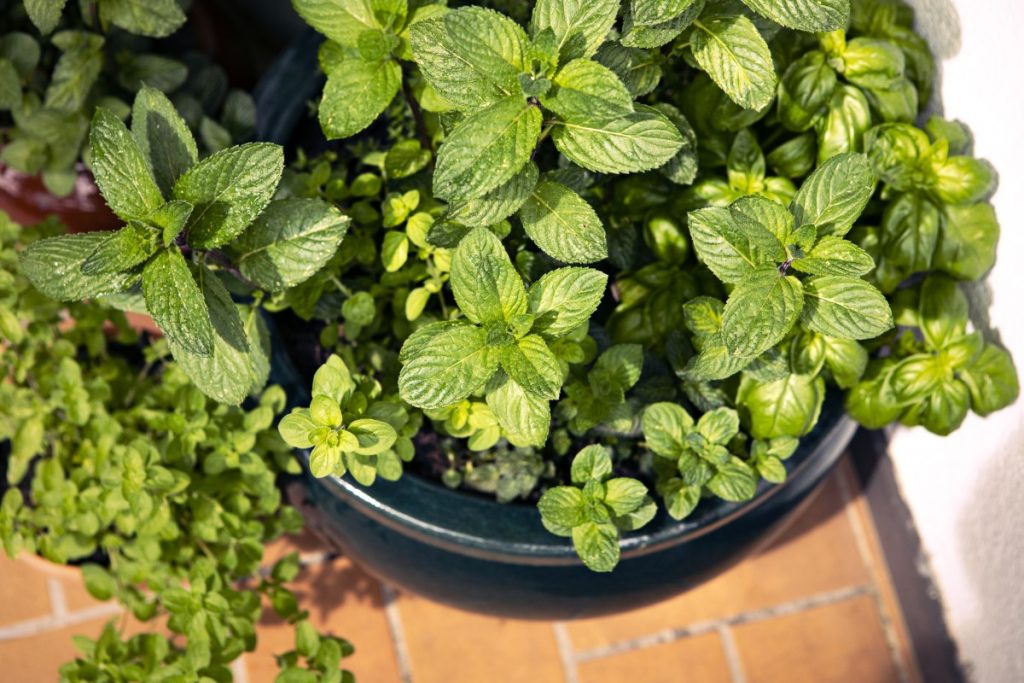
Tips for Success With Growing a Container Herb Garden
Here are some tips that address common concerns people have when creating a container herb garden for the first time.
What Herbs Can Be Grown Together in a Container?
You can grow almost any kind of herb together, as long as they like the same growing conditions.
Different plants like different amounts of light, water, and soil. It’s important to read your seed packet or instructions that come with your herb seedlings and match them accordingly.
All kinds of plants in the mint family will do well together. These include peppermint, spearmint, lemon balm, catmint and many others.
Rosemary, oregano, thyme, lavender, marjoram, and sage all like to be planted together as well. So feel free to mix and match.
How Deep Should a Container Be For Herbs?
Most herbs have fairly shallow roots. So they can do well in smaller containers. There is some variation between different herbs though.
Some plants like oregano, thyme, and chives will do well in 6 inches (15 cm) of soil.
Others like sage, mint or rosemary prefer at least 12 inches (30 cm) of soil.
Make sure to read instructions that come with the seeds or plants that you buy to see what soil conditions your herbs need.

How to Troubleshoot Issues With a Container Herb Garden
1. One herb is taking over – Some herbs like mint tend to grow like weeds, and might smother out other herbs that they’re placed in a container with.
These fast-growing and aggressive herbs should be placed in their own container. Avoid letting them spread to your garden, because they’ll take that over too.
2. Herbs are drying out – If you have houseplants, you might be used to only watering them once a week.
Herbs in outdoor containers need to be watered much more regularly. Especially during the hot summer months.
Your container herb garden is exposed to wind and sunlight, so water evaporates much more quickly.
3. Herbs are flowering – Flowers are a natural part of most plant’s life cycles. However, it’s not something you want to see with your herbs.
While flowers are nice to see, some herbs like basil can turn bitter if you let them go to flower.
Prune your herbs back regularly and remove any flower buds as soon as you see them.
4. Plants don’t have room to grow – Overplanting (planting herbs too close together) can stunt their growth or even cause some of your plants to die off.
Be sure to read the instructions that come with your plant on how to space your herbs.
When you first plant your herbs, it might seem like tons of space. But you need to account for how large your herbs will be when they’re fully grown.
5. Plants look weak or sickly – Your plant leaves might be turning yellow or brown. Or the tips of leaves might be curling up. This can be a sign of nutrient deficiency.
Don’t forget to regularly fertilize your herb containers as-directed. This will give them the nutrients that they need to grow big and strong.
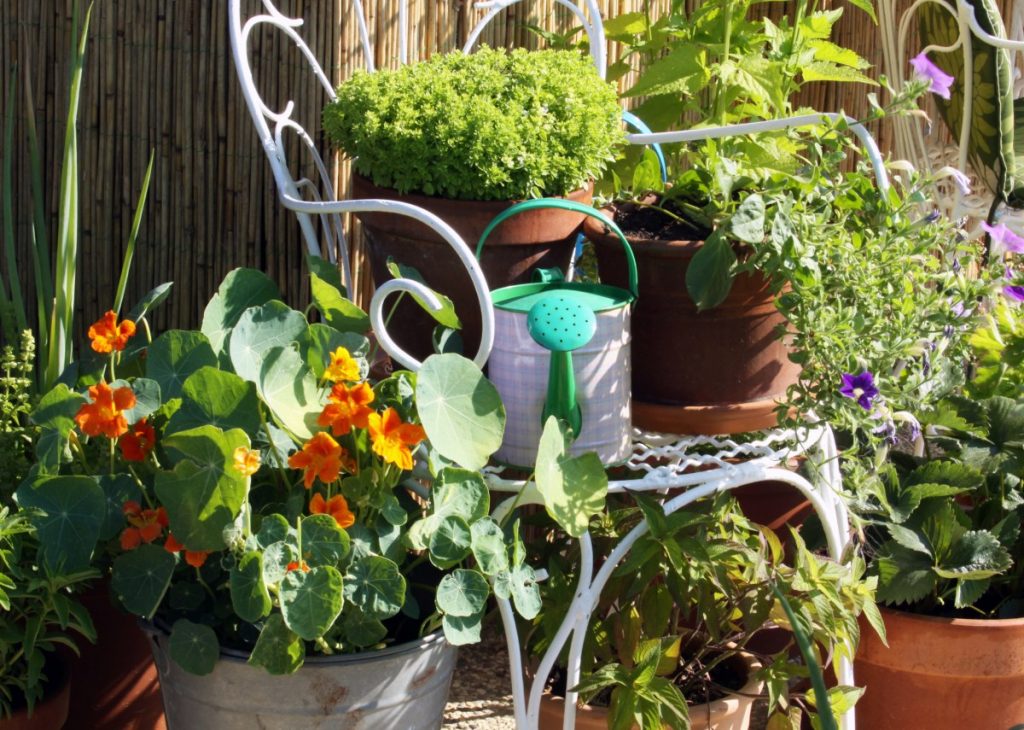
Final Thoughts
Anybody who regularly uses fresh herbs in their cooking can benefit from a container herb garden.
Container herb gardens can save you money on your grocery bills. They’re also easier and more convenient to maintain than a full-sized garden.
If you live in an apartment, a container herb garden might be all you’ve got room for. But they’re also convenient even if you’ve got several acres on your homestead.
They’re also great for beginners. So no matter what your level of experience is, you can try creating a container herb garden for yourself.
